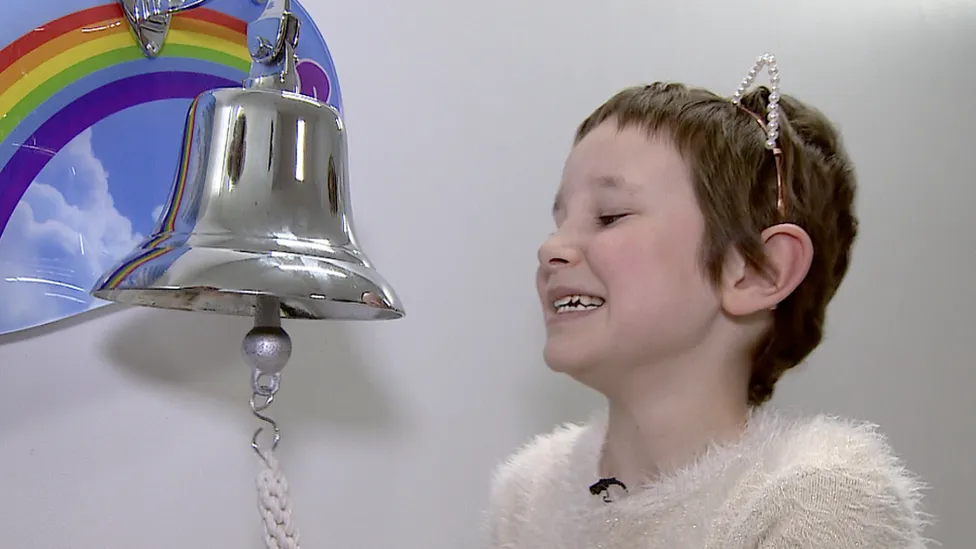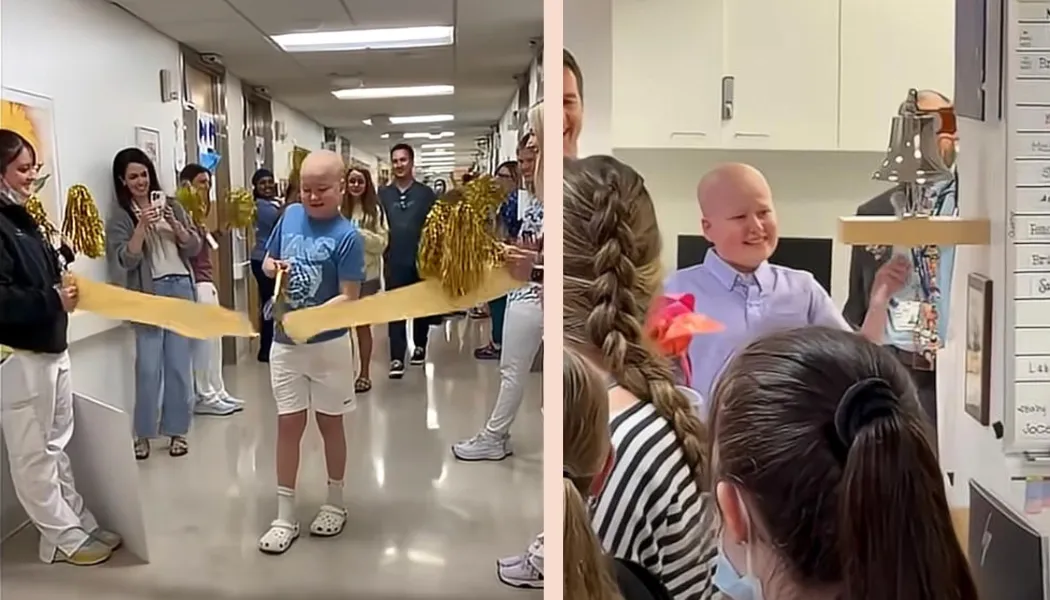When the sound of the Bravery Bell echoed through the hospital hallway, it was more than just the clanging of metal against metal. It was the sound of victory, resilience, and hope. At only fourteen years old, a young teenager—whose story has now inspired countless families—rang the bell after completing months of treatment for a rare form of pediatric bone cancer.
This milestone did not come easily. It came after long nights of pain, countless hospital stays, and a battle that demanded courage far beyond her years. Her story represents not just one child’s triumph but also the enduring spirit of children and families worldwide who face life-altering diagnoses with determination and hope.
Table of contents
The Diagnosis That Changed Everything
The journey began like so many childhood cancer stories—with something small that seemed ordinary at first. What looked like a persistent ache in her leg was initially thought to be growing pains. But as the discomfort worsened and the swelling became more noticeable, her parents knew something wasn’t right.
After a series of tests, scans, and anxious consultations, the family received the news no parent ever wants to hear: she had osteosarcoma, a rare but aggressive type of bone cancer that typically affects children and teenagers. The diagnosis turned their world upside down in an instant.
Her mother described the moment as “like the ground disappearing beneath our feet.” One moment, they were planning birthday parties and soccer games; the next, they were sitting in a hospital room listening to oncologists explain chemotherapy schedules, surgical options, and possible side effects.
But even in the face of fear, the young teenager showed remarkable resilience. Instead of withdrawing, she asked questions, wanted to know how treatments would work, and insisted on continuing to dream about her future—even as cancer threatened to derail it.
The Long Road of Treatment
Treatment was grueling. It included multiple rounds of chemotherapy, which often left her weak and nauseated, along with surgery to remove the tumor. Each stage carried its own risks and uncertainties.
Chemotherapy caused her hair to fall out, which was particularly tough for a teenager who cared about her appearance. At first, she cried when clumps of hair came out in the shower. But soon after, she made the bold choice to shave her head completely. To her family’s amazement, she began wearing colorful scarves and experimenting with hats, even joking that she had “the best hat collection in school.” What could have been a source of despair became a symbol of her courage and adaptability.
Hospital stays stretched for weeks at a time. She missed school, holidays, and weekends with friends. Yet, her hospital room became a place of creativity—decorated with posters, fairy lights, and drawings sent by classmates. Nurses often stopped by not just for medical care but to chat, admire her decorations, and be lifted by her laughter.
Pain management became another battle. Bone cancer is notoriously painful, and she endured nights where sleep seemed impossible. But she developed coping strategies—breathing exercises, listening to music, and guided visualization techniques provided by the hospital’s child life specialists. Slowly, she learned how to manage both physical and emotional pain.
The Power of Support
No child fights cancer alone. Behind her stood an army of supporters: her parents, siblings, doctors, nurses, teachers, and community.
Her father took time off work to attend every treatment session, holding her hand during infusions. Her younger brother, too young to fully understand, made her handmade cards with stick-figure superheroes labeled “You” to remind her of her strength. Friends organized fundraisers to help the family cover expenses, selling bracelets inscribed with her favorite inspirational quote: “Strong is the new beautiful.”
Teachers worked tirelessly to keep her education on track, sending assignments and arranging virtual tutoring sessions. While she sometimes fell behind, she refused to give up. “If I can beat cancer,” she said, “I can handle algebra.”
Even strangers became part of her journey. When her story spread on social media, she began receiving letters and gifts from people across the country—other children with cancer, survivors, and families who simply wanted her to know she wasn’t alone.
The Bravery Bell Tradition
The Bravery Bell is a symbol deeply woven into cancer care across hospitals worldwide. It is rung by patients on the day they complete their last chemotherapy or radiation treatment, serving as a powerful marker of resilience and a step into a new chapter of life.
When the day finally arrived for her to ring the bell, the hospital staff gathered in the hallway. Her parents stood by her side, tears already streaming down their faces. Doctors who had monitored her progress for months were there too, smiling proudly. Even fellow patients who were still undergoing treatment gathered to watch, taking hope from her achievement.

As she rang the bell three times, cheers erupted, echoing through the halls. Nurses clapped, family members hugged, and she beamed with a mixture of relief, pride, and joy. “This is the sound of freedom,” she whispered afterward.
The bell ceremony was not just for her—it was for every child in the hospital fighting cancer, for every family waiting for good news, and for every survivor who remembers the bittersweet mix of triumph and loss that comes with the end of treatment.
Understanding Pediatric Bone Cancer
Osteosarcoma, the type of cancer she battled, is rare but devastating. It occurs most often in the long bones, such as the legs or arms, and primarily affects children, teenagers, and young adults.
Treatment usually involves chemotherapy to shrink the tumor, followed by surgery to remove it, and then additional chemotherapy to eliminate any remaining cancer cells. For some children, amputation may be necessary, though advances in limb-sparing surgery have given many the chance to maintain mobility.
The survival rate for osteosarcoma has improved over the past few decades, thanks to medical progress. But the journey remains daunting, both physically and emotionally. Families often face long hospital stays, side effects, and the constant anxiety of recurrence.
This teenager’s recovery highlights not only her strength but also the importance of continued research into pediatric cancers. While rare, they present unique challenges, and funding for research is often limited compared to adult cancers. Her story underscores the need for ongoing investment in treatments that improve survival rates and quality of life for young patients.
Life After Cancer
Ringing the Bravery Bell does not mean the end of the journey—it marks a new beginning. Life after cancer comes with its own challenges, including rehabilitation, follow-up scans, and lingering side effects from treatment.
For her, the recovery process includes physical therapy to regain strength in her leg, ongoing checkups to monitor for recurrence, and the gradual process of reintegrating into normal teenage life. She dreams of returning to sports and school dances, but for now, she is focusing on celebrating the everyday joys: walking in the park, laughing with friends, and enjoying meals without nausea.
Emotionally, the transition can be difficult. Survivors often face “scanxiety”—the fear that every follow-up scan might bring bad news. But she is determined to live fully, refusing to let fear overshadow her triumph.
Lessons for Families and Communities
Her story offers valuable lessons for families and communities supporting children with cancer:
- The importance of early detection: Persistent pain, swelling, or changes in mobility should never be ignored. Early diagnosis can make a significant difference.
- The power of positivity: While cancer is daunting, maintaining hope and focusing on small victories—like a good lab result or a day without nausea—helps families cope.
- The strength of community: Whether it’s fundraising, sending messages, or providing meals, community support plays a critical role in helping families endure the challenges.
- Resilience of children: Perhaps the most inspiring lesson is the strength of young patients themselves. Their ability to adapt, find joy, and keep dreaming even in the darkest times is extraordinary.
A Story of Hope for Others
Her ringing of the Bravery Bell is not just a personal victory; it is a beacon of hope for other children fighting cancer. Families who hear her story are reminded that survival is possible, that strength can be found in unexpected places, and that even in the hardest times, there are reasons to celebrate.
For hospitals, the ceremony reinforces the importance of holistic care—not just treating the disease, but also supporting the emotional and psychological needs of patients and families. For communities, it shows how collective support can ease the weight of illness and help families feel less alone.
Looking Toward the Future
As she steps forward into her teenage years, she carries with her not just the scars of battle but also the wisdom of someone who has faced mortality and triumphed. She hopes to one day advocate for pediatric cancer awareness and support other children going through treatment. Her dream, she says, is to become a nurse—so she can give back the same care that she received.
Her future is wide open, filled with possibility. And every time she thinks back to the moment she rang the Bravery Bell, she will remember that she is not defined by cancer but by her courage.
Conclusion
The story of this 14-year-old who rang the Bravery Bell after beating rare pediatric bone cancer is more than just a medical success story—it is a testament to resilience, community, and hope. It reminds us that even in the face of the harshest challenges, the human spirit can shine with unbreakable strength.
Her journey illustrates that recovery is possible, life after cancer can be full of joy, and every victory—big or small—is worth celebrating. For anyone facing hardship, her story is a powerful reminder: no matter how dark the road, there is always light ahead.
When the bell rang that day in the hospital, it carried a message beyond those walls. It told the world that courage, love, and hope can overcome even the fiercest battles. And for one young girl, it marked the beginning of a new chapter—one filled with dreams, laughter, and the promise of a future beyond cancer.
